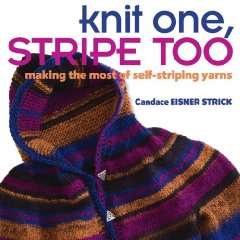I ran across this book, ‘Knit One, Stripe Too’ by Candace Eisner Strick today at the library. This book is a gem! I only wish the author had considered crocheters in her notes on self-striping yarn. It’s all about knitters. But, even with this defect, there’s so much great information in this useful little book that we may well forgive Ms. Strick for her crochet shortcomings.
What’s so great about this book? Well, lot of things. I already knew that self-striping yarns and other variegated and ombre yarns have differing lengths of color runs. Strick calls these short runs and long runs. Two yarns are pictured next to one another, one with color stripes from 1.5 to 9 inches long. The other yarn has strips of color running for 6.5 yards. The implications of the length of color runs is covered in detail (all about knit stitches per inch on different sizes of knitting needles). We crocheters can generalize this information to crochet with a calculator and a bit of imagination.
Dye lots are discussed at length. Two skeins may appear very unlike but may well be from the same dye lot. The way the yarn is wrapped is important. Knots in the yarn are important. An even more important aspect of the dye lot, knots, and wrap issue is matching. How will you match one skein to another in the middle of a color block when you run out of yarn or encounter a knot that messes up your color run?? Strick explains how, why, and how to work around these problems.
Another type of self-striping yarn is presented – different textures within one skein of yarn. I have seen these balls of yarn but had never given any thought to how the texture changes might present either design problems or design possibilities. Sometimes color and texture runs occur in one skein of yarn. That gives even more possibilities to consider. Are you up to it??
The key here is that there are LOTS of design possibilities with self-striping yarns. These vary from simple stripes – we’ve all seen those – to the technique of making smaller circles with striping yarns that create a visual ‘donut’ effect and join them to create a larger garment. Also explored are the visual potential of modulars and geometrics, both of which can be displayed especially nicely with self-striping yarns.
While this book is definitely aimed at knitters, it’s a valuable read for crocheters too. There’s an awful lot of research, creativity, and inspiration in these 96 pages. Lots of color photos and several patterns which could be easily translated into crochet. Check it out!
Book Stats:
Softcover, 96 pages, 2007 by Martingale & Company, ISBN9781564777553.


Leave a Reply